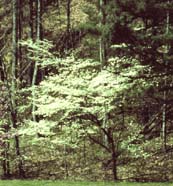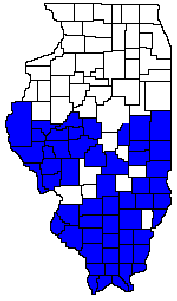 |
| Flowering
Dogwood (Cornus florida)
Distribution
Map to Right |

Flowering dogwood is a small to medium-sized tree that is typically an understory species in mesic forests. It can reach heights of 40 feet, but is usually smaller, with a trunk diameter of 2 feet or less. It has upturned branches and a flattened to rounded crown. It prefers well-drained, rich soils and is a common component of the eastern deciduous forest. It has a broad range that extends from Maine to Florida in the east to as far west as east Texas.
Interesting
Facts
Flowering
dogwood is widely used for landscaping because it attractive throughout
the year, with these characteristics:
- The large flower bracts, which appear in April or May, are probably the most attractive feature. The flower bracts are often mistaken for petals, but are actually petal-like structures that occur beneath the true flowers, which are crowded together in yellowish-green clusters above and at the center of four white (occasionally pinkish) bracts.
- Cultivated trees are bred for showy bracts ranging from deep pink to white. The shape is attractive and the tree not overwhelmingly large.
- The leaves turn showy red in the autumn.
- The fruits also appear in late autumn, as clusters of oval, shiny, red berries, up to 1/2 inch long.
BarkUses
The bark is light gray and smooth when the tree is young. As it grows, the bark becomes grayish brown and develops a distinctive blocky pattern that looks like alligator skin.
Twigs
The twigs are slender and sometimes greenish to light brown, but frequently purplish and upturned at the tip. The twigs and branchlets are frequently swollen due to insect attacks. The leaf buds are slender and pointed, whereas the flower buds are stalked and globular (described as "biscuit shaped" by some).
Leaves
The leaves are opposite, simple, oval and up to 5 or 6 inches long and less than half as wide. They are pointed at the tip and have smooth (as opposed to toothed), slightly wavy margins. They are typically shiny green and smooth on the upper surface and paler on the lower surface, but may be sparsely hairy on the upper surface as well as the lower. The leaf veins are conspicuous and deeply impressed. The leaf stalks are less than 1 inch long and can also be either smooth or hairy.
Flowers
The flowers occur in small, greenish - yellow, inconspicuous clusters at the center and above four large, showy white to pinkish bracts. They bloom in late April or May.
Fruits
The fruits are red, oval berries (drupes) that grow in clusters. They appear in autumn.
Flowering dogwood has hard, close-grained wood. It is used for tool handles, mallets, and heads of golf clubs. A red dye can be made from the bark of the roots. The powdered bark of the trunk was reportedly used in toothpaste and black ink, and as an aspirin-like substance. Song and game birds eat the berries and deer browse the twigs. The most widespread use of flowering dogwood, however, is as a landscape ornamental.